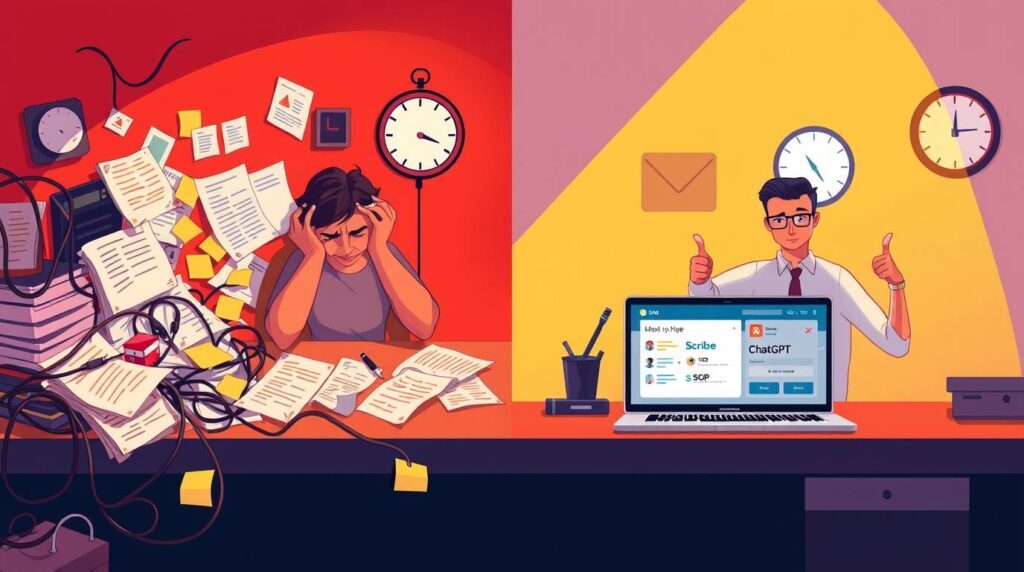Remember that sinking feeling? The one that hits when you realize you need to document another complex process? Your team needs a Standard Operating Procedure (SOP), but the thought of writing it – capturing every click, every nuance, every potential pitfall – feels like climbing Everest in flip-flops. You know SOPs are the backbone of consistency, efficiency, and compliance (just ask McKinsey), but the sheer effort involved often pushes them to the bottom of the to-do list. Sound familiar?
For years, creating effective SOPs meant endless screenshots, frustrating screen recordings, and wrestling with clunky documentation tools. The result? Outdated guides, inconsistent practices, and wasted hours that could fuel actual growth. But what if I told you the landscape has fundamentally shifted? What if you could automate a staggering 80% of the SOP creation grind? Enter the dynamic duo: Scribe and ChatGPT. This isn’t just about using AI; it’s about a transformative workflow that turns SOP creation from a chore into a strategic advantage.
Why Traditional SOP Creation is Broken (And Why You Need This Fix)
Let’s be brutally honest: the old way of creating SOPs is inefficient, painful, and often ineffective. Here’s the harsh reality:
- Time Sink: Documenting even a moderately complex process manually can take hours. Capturing screenshots, annotating them, writing clear step-by-step instructions… it adds up fast.
- Inconsistency: Different authors mean different styles, levels of detail, and formatting. This makes it harder for users to follow and undermines the SOP’s purpose.
- Rapid Obsolescence: Processes change. Software updates. Manually updating SOPs to reflect these changes is often neglected, leading to dangerously outdated instructions.
- Engagement Killer: Text-heavy, poorly formatted SOPs are tedious to read and difficult to follow, leading to low adoption and compliance.
- Scalability Nightmare: As your company grows and processes multiply, manually creating and maintaining SOPs becomes utterly unsustainable.
This is where automation isn’t just nice-to-have; it’s essential for operational survival. And that’s precisely the gap Scribe and ChatGPT fill, together.
Meet the Players: Scribe & ChatGPT – A Powerhouse Combo
Before we dive into the magic of their combination, let’s understand what each tool brings to the table:
- Scribe: The Process Capture Genius
- What it does: Scribe is a browser extension and desktop app that automatically documents processes as you perform them. Click ‘record’, walk through the steps, and Scribe generates a visual, step-by-step guide complete with screenshots, text descriptions, and click annotations. Think of it as your tireless process documentation assistant.
- The Core Strength: Capturing the exact sequence of actions, clicks, and inputs required for a task with incredible speed and accuracy. It eliminates the manual screenshot/annotation nightmare. (See Scribe’s official features)
- The Gap: While Scribe excels at capturing the how, it often needs help with the why, context, deeper explanations, warnings, and polished language. Its auto-generated text can be functional but sometimes lacks nuance or broader applicability.
- ChatGPT: The Context & Language Maestro
- What it does: ChatGPT (like the model powering this text!) is a powerful large language model (LLM) capable of understanding and generating human-quality text. You give it a prompt (instructions), and it produces coherent, contextually relevant output.
- The Core Strength: Explaining concepts, generating clear and engaging text, summarizing information, answering questions, translating, adapting tone, and adding crucial context or rationale. It excels at the communication layer. (Learn more about OpenAI’s ChatGPT)
- The Gap: ChatGPT doesn’t inherently know your specific software interface or the exact sequence of clicks required for your internal process. It needs the raw material to work its magic.
The “Aha!” Moment: Scribe provides the perfect raw material – the precise step-by-step actions – that ChatGPT needs. ChatGPT then elevates that raw material into a polished, comprehensive, context-rich SOP. It’s a match made in operational efficiency heaven.
How It Works: Automating SOP Creation Step-by-Step
The beauty lies in the seamless workflow. Forget months; you can create robust SOPs in minutes. Here’s the proven method:
- Record the Process with Scribe: Identify the process needing documentation (e.g., “Onboarding a New Client in CRM X”). Open Scribe, hit record, and perform the task exactly as you want it documented. Navigate through screens, enter data, make selections. Scribe silently captures every click and input.
- Generate the Scribe Draft: Stop recording. Scribe instantly generates a visual guide. This includes numbered steps, annotated screenshots showing exactly where clicks occurred, and basic auto-generated text descriptions (e.g., “Click the ‘Add Client’ button”).
- Feed Scribe Output to ChatGPT: This is where the magic amplification happens. Copy the text from the Scribe guide (usually accessible in a sidebar or export view). Head over to ChatGPT.
- Craft Your Super-Prompt: Don’t just dump the text! Give ChatGPT clear instructions. Here’s a powerful template you can adapt:
**Role:** You are an expert Technical Writer specializing in creating clear, concise, and compliant Standard Operating Procedures (SOPs) for businesses.
**Task:** Transform the raw process documentation below into a professional SOP. The raw steps were captured automatically using Scribe.
**Raw Process Documentation from Scribe:**
[PASTE THE COPIED SCRIBE TEXT STEPS HERE]
**Instructions:**
1. **Structure:** Format the SOP using clear headings: Purpose, Scope, Prerequisites, Step-by-Step Instructions, Troubleshooting (if applicable), References/Links.
2. **Enhance Clarity:** Rewrite the step descriptions to be more action-oriented and user-friendly (e.g., "Navigate to" instead of just "Click"). Ensure language is clear, concise, and avoids jargon where possible. If a step is ambiguous in the Scribe text, infer the logical action based on context or add a placeholder note like "[Specify expected data]".
3. **Add Context:** For critical or potentially confusing steps, add a brief "Why" or "Note" explaining the purpose or a common pitfall (e.g., "Note: Selecting the correct client type is crucial for routing in the next stage").
4. **Incorporate Best Practices:** Include relevant safety warnings, compliance reminders (e.g., data privacy considerations like GDPR or HIPAA if applicable), or quality control checks where logically needed. Add placeholders like "[Add specific compliance rule reference]" if needed.
5. **Troubleshooting:** Based on the process, suggest 2-3 common errors users might encounter at key steps and provide basic solutions (e.g., "Error: 'Client ID not found'. Solution: Verify the client ID was entered correctly in Step 3.").
6. **Tone:** Maintain a professional yet approachable tone suitable for the intended audience (e.g., new hires, specific department).
The Transformation: Raw Scribe vs. Scribe + ChatGPT SOP
| Feature | Raw Scribe Output | Scribe + ChatGPT Enhanced SOP |
| Step Descriptions | Basic, functional (“Click here”) | Clear, action-oriented (“Navigate to Settings > Accounts”) |
| Context/Why | Minimal or none | Added explanations & rationale for key steps |
| Structure | Linear steps only | Formal SOP structure (Purpose, Scope, Steps, Troubleshooting) |
| Warnings/Notes | Rarely included | Proactively added for risks & compliance |
| Troubleshooting | Absent | Common errors & solutions included |
| Tone & Polish | Functional, sometimes robotic | Professional, consistent, audience-appropriate |
| Compliance Hooks | None | Placeholders/reminders for specific regulations |
| Time Investment | Minutes (Capture) | Minutes (Capture + AI Enhancement + Review) |
Beyond the Basics: Unleashing Advanced Automation & Consistency
The core workflow is revolutionary, but the Scribe + ChatGPT combo offers even more power:
- Version Control & Updates Made Easy: Process changed? Record the new version in Scribe. Feed the updated Scribe steps + the old ChatGPT-enhanced SOP to ChatGPT with a prompt like: “Compare the old SOP below with the updated process steps captured by Scribe. Highlight the key changes needed in the SOP and generate a revised draft.” This drastically simplifies maintenance. Learn more about AI in technical documentation trends.
- Ensuring Brand Voice & Style Consistency: Train ChatGPT! Feed it a few examples of your existing well-written SOPs or style guides. Add to your prompt: “Maintain a consistent tone and style matching our brand guidelines. Use active voice and avoid technical jargon where possible. Refer to these examples: [Paste example snippets].” This ensures every new SOP sounds like it came from your team.
- Generating Multiple Outputs from One Capture: Use the same Scribe recording to fuel different outputs via ChatGPT prompts:
- Quick Reference Guide: “Create a condensed one-page cheat sheet highlighting only the 5-7 most critical steps from the full SOP.”
- Training Slide Deck Outline: “Generate an outline for a 10-minute training presentation based on this SOP, including key learning objectives and slide topics.”
- Knowledge Base Article: “Repurpose this SOP into a FAQ-style knowledge base article addressing common user questions about this process.”
- Localization (Basic): “Translate the following SOP steps into [Spanish/French/etc.], maintaining technical accuracy.” (Always have a native speaker review!).
Real-World Impact: More Time, Better SOPs, Happier Teams
The benefits aren’t theoretical; they’re tangible:
- Massive Time Savings: This is the biggest win. What used to take 2-4 hours can now be done in 20-30 minutes. That’s an 80%+ reduction in documentation time. Multiply that across dozens of processes.
- Dramatically Improved SOP Quality: SOPs are clearer, more comprehensive, include essential context and warnings, and adhere to best practices consistently.
- Enhanced Compliance & Risk Reduction: Proactively including compliance reminders and safety warnings becomes effortless, reducing operational risk.
- Faster Onboarding & Ramp-Up: New hires get accurate, easy-to-follow guides, accelerating their productivity.
- Increased Adoption: Well-written, visually supported SOPs are actually used by teams.
- Scalability: Documenting processes across departments or as the company grows is no longer a bottleneck.
A Personal Note: I recently documented a complex data reconciliation process involving 4 different systems. Manually, this would have been a half-day nightmare of screenshots and frustration. Using Scribe + ChatGPT? I recorded the walkthrough in Scribe (8 mins), fed it to ChatGPT with a detailed prompt (2 mins), reviewed and lightly edited the excellent output (10 mins), and inserted Scribe’s screenshots (5 mins). Total time: ~25 minutes. The result was a SOP far better than anything I could have produced manually in under two hours. The time savings and quality boost are genuinely transformative.
Navigating Potential Pitfalls: Best Practices for Success
While powerful, this approach requires mindful implementation:
- Accuracy is Paramount (Garbage In, Garbage Out): If your Scribe recording misses a step or includes an error, ChatGPT will amplify it. Always perform the process correctly and completely while recording. Double-check the Scribe output before feeding it to AI.
- ChatGPT is Not Omniscient: It generates text based on patterns. It won’t inherently know your company’s specific compliance rules (like the exact HIPAA clause) or ultra-niche internal acronyms. You MUST review its output critically. Fill in placeholders ([ ]), verify technical accuracy, and add truly specific knowledge.
- Security & Privacy: Never feed sensitive data (PII, passwords, confidential financials) into public ChatGPT interfaces. Use dummy data in your Scribe recordings when possible. Be mindful of your company’s AI usage policies regarding data. Consider enterprise solutions like Azure OpenAI Service or ChatGPT Enterprise for enhanced security if handling sensitive processes.
- The Human Touch is Irreplaceable: ChatGPT is a powerful assistant, not a replacement for subject matter expertise (SME) review. Always have the process owner or SME review the final SOP for technical accuracy and completeness. Your review is crucial for catching AI hallucinations or misinterpretations.
- Visual Integration: Remember the workflow: Scribe provides the visual proof (screenshots), ChatGPT provides the enhanced text. You need to combine them in your final document platform (Docs, Confluence, etc.). Factor this step into your process.
Ready to Ditch the SOP Dread? Start Automating Today!
Stop letting SOP creation bottleneck your operations and drain your team’s energy. The combination of Scribe’s effortless process capture and ChatGPT’s intelligent text enhancement is a game-changer.
Here’s Your Clear Call to Action:
- Try Scribe: Sign up for a free Scribe account (Scribe Free Plan) and install the extension. Record one simple process you’ve been dreading documenting. See how fast it captures the steps.
- Experiment with ChatGPT: Take the text output from your Scribe recording and plug it into ChatGPT (free version works) using the prompt template provided earlier. Witness the transformation.
- Refine & Implement: Review the AI output, add your specific details and screenshots, get SME sign-off, and publish your first AI-augmented SOP!
- Scale & Optimize: Start building your library. Experiment with different prompts for different outputs (cheat sheets, training outlines). Train ChatGPT on your style guide.
Share Your Journey! I’d love to hear about your experiences automating SOPs. What process did you document first? How much time did you save? What challenges did you overcome? Share your wins, tips, or questions in the comments below! Let’s build a community of efficient, automated operations together.
The era of painful, manual SOP creation is over. Embrace the automation revolution and empower your team.
👉 For more Artificial Intelligence Tools → Click here!




